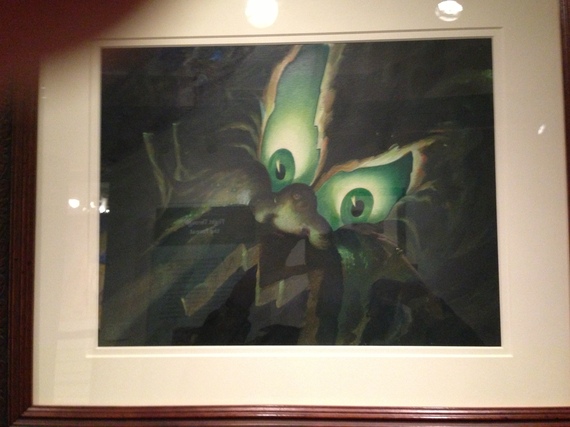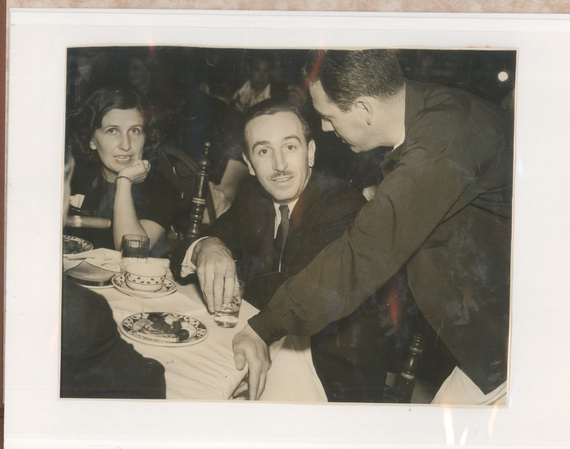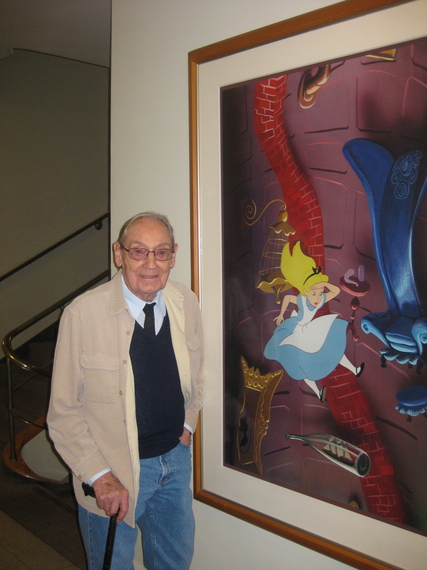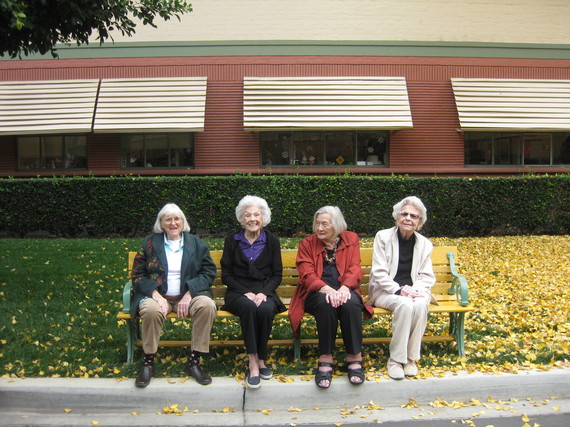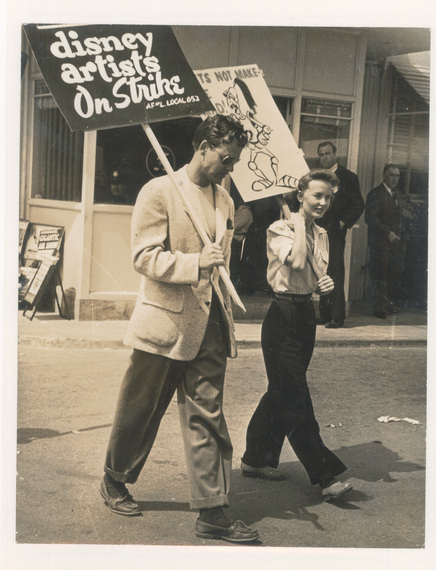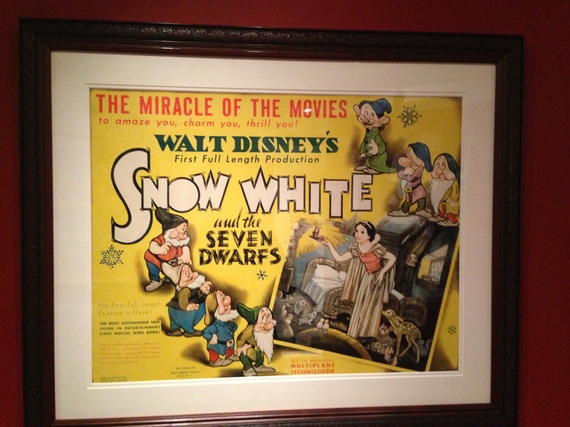Walt Disney seated with drawing board on his lap and representations of his creations Mickey and Minnie Mouse behind. October 1, 1933. Credit: © Condé Nast Archive/Corbis
Walt Disney was a complicated man. Walt Disney was a simple man. Which is it? The American Experience tries to get at the heart and soul of the brilliant entertainment innovator who became a brand. In almost four hours and many Disney scholars later, they largely succeed.
Disney Studios Golden Age animation art, courtesy Walt Disney Family Museum
What makes this documentary airing in two parts tonight and tomorrow night on PBS oh so very special is that American Experience was allowed into the Disney archives. It is very, very hard to get into the archives. I was permitted in during the course of my research for my Vanity Fair story on the Ink and Paint Department during Disney's Golden Age. I sat there after years of painstaking and exhilarating research outside the studio with the surviving members of that department and their colleagues in animation and looked around me knowing that the most splendid things: photographs, footage, articles, posters and internal newspapers and flyers still lay waiting in these boxes and storage cans. It was a thrilling -- and daunting -- moment.
Inside the Walt Disney Studios Animation Building, photograph by Patricia Zohn
For the first time, some of this material -- beautiful Technicolor home movies of the studio's early days, production on Mickey Mouse, the Silly Symphonies, Snow White, Pinocchio, Bambi, Fantasia, are available in this documentary for all to see. Walt (as he insisted on being called by his staff) was a tech junkie before such a term existed. Like Steve Jobs, Walt was able to encourage innovative technology and marry it to art in a truly groundbreaking way. If it was also a backbreaking way, for his staff; well, that is the high price we often pay for genius.
Walt Disney, left side standing in rear, and some of his animators in the new animation building at Hyperion Studios in 1931. Seated L-R: Dave Hand, Johnny Cannon, Rudy Zamora, Les Clark. Standing: Walt Disney, Tom Palmer, Ben Sharpsteen. Credit: David Lesjak
Walt's favorite themes re-emerge in all his work: What does it mean to be human? How do outsiders struggle for acceptance? What's it like to come of age? Does temptation always lead to loss, survival and redemption? Walt began with fairy tales and legends and came to see his own life in these mythological terms.
Walt Disney during the early years, courtesy McSpadden Family Archives
Theoretically, this is a story of Walt himself, the Midwestern beginnings in commercial art, the early days of Laugh-O-Grams, the Alice series, Mickey Mouse, the move to LA with brother Roy to begin their own studio which grew and grew and grew just like Pinocchio's nose, the pull-himself-up-by-his-bootstraps legend. It does not dwell on the mammoth corporation that evolved alongside Walt although it makes clear that Walt himself was the author of the massive merchandising that became one of the biggest revenue streams for the company. Walt was often poised on the brink of economic failure but his constant re-invention--and the dogged efforts of his brother Roy--helped pave the way to enduring commercial success.
The creation of first the cozy, family-style Hyperion Studio, and then the more corporate, factory-style Burbank studio, with its strict rules and hierarchies, is vividly drawn. Two of my favorite interviews, Ruthie Thompson, 105, from the Ink and Paint department, a lifetime loyalist who was with Walt from the very beginning (whom I spent hours with at the Motion Picture Home) and Don Lusk, 101, (who still lived on his own when I met with him and served me lunch) who was an animator and who went out on strike are able to give divergent views of the man behind the magic. Clearly, despite years of grueling work, both have survived and we are extremely lucky to have their eyewitness remembrances.
Don Lusk in the Animation building at the Disney studios during the Vanity Fair shoot, photograph by Patricia Zohn
Members of the Ink and Paint department reunite at the Disney Animation Building during the Vanity Fair Shoot, including Ruthie Thompson, Yuba Pillet O'Brien, June Patterson photo by Patricia Zohn
Look at how gorgeous they and all their coworkers were in this exclusive clip from the documentary I was able to obtain for HuffPost. They truly were golden: handsome and beautiful, athletic, like college students and post grads cavorting on campus. They said Walt did not recruit based on looks, but it's hard to believe that looking at the footage. There was a Disney style (v-neck sweaters and ties, floral dresses) even in the rank and file who were exceedingly proud to have been admitted to this very exclusive club of talented people.
Exclusive footage of early Disney Studios days from American Experience Documentary
But inevitably, the politics of Walt's times interrupts, especially the surge of unionism in Hollywood and the chapter-closing strike which disrupted his life's work and changed the way he viewed his creation and the people who had worked day and night alongside him to make the magic. The story of the strike and its repercussions, though told in many books, is here for the first time made very visceral.
Bill Keil (animator) and Jeanne Keil (Ink and Paint) march on strike at the Disney Studios, photo courtesy Keil Family Archives
Seeing the handsome Art Babbitt--the animator who was to become the special thorn in Walt's side--and his home movies illuminates just how personally Walt was bound up with those artists closest to him and how enraged he became when they "turned" on him in solidarity with the lower paid, undercredited, overworked rank and file. Walt went on to be a rabid "Commie" hater, testified at the HUAC hearings and was completely paranoid about the pollution of his special world.
Snow White Poster, courtesy Walt Disney Family Museum and Disney Studios archives
The film is wonderful on process: the gestation of the films is thoroughly analyzed and though the Disneyland sequence in part two seems endless (for me and for some others Disneyland is much more of a mixed bag ), it situates Walt as not only a motion picture maverick, but the inventor of a whole new form of particularly American-style entertainment. Where the films exploit dark fairy tales and are not afraid of inducing fear, the parks are virtual worlds of clean, safe, bright. They are Walt's withdrawal into his own fantasyland after the blow of the strike. "Why would I want to be president," Walt said after the first park opened, "I'm the King of Disneyland."
The documentary does not dwell on the darker side of Walt, though it acknowledges his sexism, his racism, his paternalism, his abject fear of communism, his dictatorial style. The treatment is even-handed if not especially deep. It's worthwhile exploring the webpages for the film which have added material and the Neal Gabler biography (Gabler appears as a talking head) for further detail.
If you have not been to the lovely David Rockwell-designed Walt Disney Museum in San Francisco's Presidio district, that is another way to learn in more detail about Walt, though as created by his daughter Diane entirely separate from the studio in an effort to burnish his legend, it inevitably falls into hagiography. Or, you can visit Banksy's recently opened Dismaland in England which explores the darker side of the Disney legend.
Like Jobs, Disney will continue to be picked over and analyzed, and more will continue to be revealed about this simple/complicated man. Stay tuned.
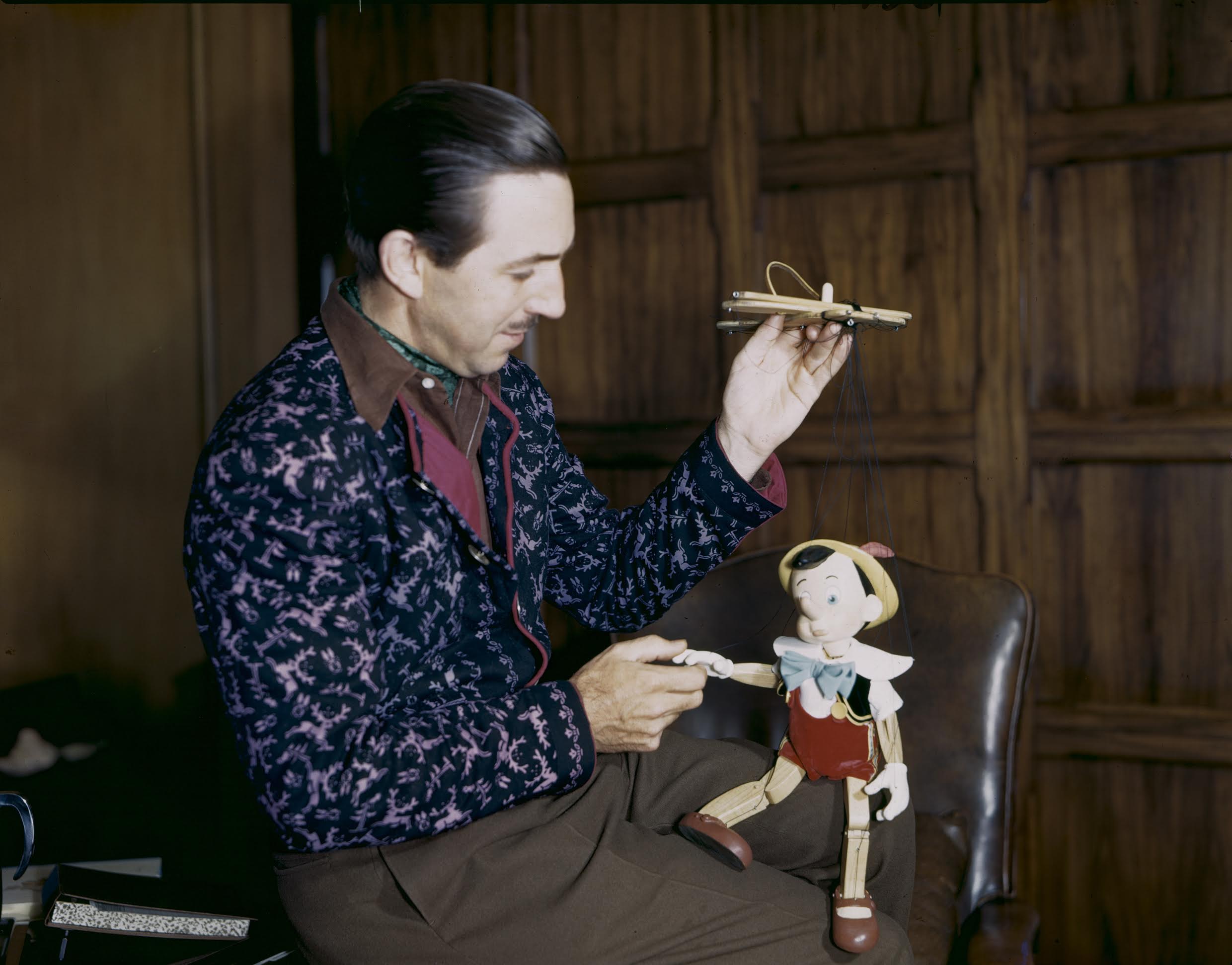
Walt Disney examines a Pinocchio marionette created by the newly established character model department during production of the animated feature, circa 1939.Credit: © Disney


